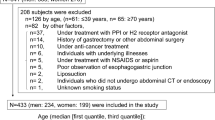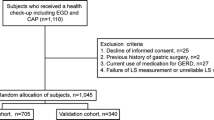Abstract
Background
The impact of obesity on gastroesophageal reflux disease remains controversial. We undertook this study, with a large sample size, to investigate risk factors for endoscopic erosive esophagitis by multivariate analysis, including visceral adipose tissue (VAT) and subcutaneous adipose tissue (SAT) as covariates.
Methods
Japanese males who visited our institute for a comprehensive medical survey between 2007 and 2010 were enrolled. All subjects voluntarily participated in a self-paid health check-up program including blood test screening, physical examinations, and esophagogastroduodenoscopy. VAT and SAT were measured by computed tomography at the navel level. Independent and significant predictors of erosive esophagitis were determined by multivariate analysis.
Results
Of 9840 eligible subjects, 1831 (18.6%) were diagnosed with erosive esophagitis. Body mass index and triglyceride were predictors of an increased prevalence of erosive esophagitis (odds ratios [ORs] = 1.063 and 1.001; 95% confidence intervals [CIs] = 1.020–1.108 and 1.001–1.002; p = 0.004 and <0.001, respectively). Heavy alcohol consumption, heavy smoking, and hiatal hernia were also associated with an increased prevalence of erosive esophagitis (ORs = 1.276, 1.399, and 2.758; 95% CIs = 1.085–1.501, 1.220–1.605, and 2.474–3.075; p < 0.001 for all). Helicobacter pylori infection significantly and independently decreased the prevalence of erosive esophagitis (OR = 0.346, 95% CI = 0.299–0.401, p < 0.001). Central obesity, as determined by VAT and waist girth, did not confer an increased risk of erosive esophagitis after adjusting for confounders.
Conclusions
Lifestyle factors including heavy alcohol consumption, heavy smoking, metabolic disorders, and hiatal hernia increased the risk of erosive esophagitis, but central obesity did not.
Similar content being viewed by others
References
Locke GR 3rd, Talley NJ, Fett SL, Zinsmeister AR, Melton LJ 3rd. Prevalence and clinical spectrum of gastroesophageal reflux: a population-based study in Olmsted Country, Minnesota. Gastroenterology. 1997;112:1448–56.
Vakil N. Dyspepsia, peptic ulcer, and H. pylori: a remembrance of things past. Am J Gastroenterol. 2010;105:572–4.
Wu JC. Gastroesophageal reflux disease: an Asian perspective. J Gastroenterol Hepatol. 2008;23:1785–93.
Miyamoto M, Haruma K, Kuwabara M, Nagano M, Okamoto T, Tanaka M. High incidence of newly developed gastroesophageal reflux disease in the Japanese community: a 6-year follow-up study. J Gastroenterol Hepatol. 2008;23:393–7.
Shim KN, Hong SJ, Sung JK, Park KS, Kim SE, Park HS, et al. Clinical spectrum of reflux esophagitis among 25536 Koreans who underwent a health check-up: a nationwide multicenter prospective, endoscopy-based study. J Clin Gastroenterol. 2009;43:632–8.
Lagergren J, Bergström R, Lindgren A, Nyrén O. Symptomatic gastroesophageal reflux as a risk factor for esophageal adenocarcinoma. N Engl J Med. 1999;340:825–31.
Grande M, Cadeddu F, Villa M, Attinà GM, Muzi MG, et al. Helicobacter pylori and gastroesophageal reflux disease. World J Surg Oncol. 2008;6:74.
Nordenstedt H, Nilsson M, Johnsen R, Lagergren J, Hveem K. Helicobacter pylori infection and gastroesophageal reflux in a population-based study (The HUNT Study). Helicobacter. 2007;12:16–22.
El-Serag HB, Ergun GA, Pandolfino J, Fitzgerald S, Tran T, Kramer JR. Obesity increased oesophageal acid exposure. Gut. 2007;56:749–55.
El-Serag HB, Tran T, Richardson P, Ergun G. Anthropometric correlates of intragastric pressure. Scand J Gastroenterol. 2006;41:887–91.
DeVault KR, Castell DO. Updated guidelines for the diagnosis and treatment of gastroesophageal reflux disease. Am J Gastroenterol. 2005;100:190–200.
Labenz J, Jaspersen D, Kulig M, Leodolter A, Lind T, Meyer-Sabellek W, et al. Risk factors for erosive esophagitis: a multivariate analysis based on the ProGERD study initiative. Am J Gastroenterol. 2004;99:1652–6.
Breckan RK, Paulssen EJ, Asfeldt AM, Mortensen L, Straume B, Florholmen J. The impact of body mass index and Helicobacter pylori infection on gastro-oesophageal reflux symptoms: a population-based study in Northern Norway. Scand J Gastroenterol. 2009;44:1060–6.
Corley DA, Kubo A. Body mass index and gastroesophageal reflux disease: a systematic review and meta-analysis. Am J Gastroenterol. 2006;101:2619–28.
El-Serag HB, Graham DY, Satia JA, Rabeneck L. Obesity is an independent risk factor for GERD symptoms and erosive esophagitis. Am J Gastroenterol. 2005;100:1243–50.
Lee SJ, Song CW, Jeen YT, Chun HJ, Lee HS, Um SH, et al. Prevalence of endoscopic reflux esophagitis among Koreans. J Gastroenterol Hepatol. 2001;16:373–6.
Chang CS, Poon SK, Lien HC, Chen GH. The incidence of reflux esophagitis among the Chinese. Am J Gastroenterol. 1997;92:668–71.
Kang MS, Park DI, Oh SY, Yoo TW, Ryu SH, Park JH, et al. Abdominal obesity is an independent risk factor for erosive esophagitis in a Korean population. J Gastroenterol Hepatol. 2007;22:1656–61.
Lagergren J, Bergstrom R, Nyren O. No relation between body mass and gastro-oesophageal reflux symptoms in a Swedish population based study. Gut. 2000;47:26–9.
Corley DA, Kubo A, Zhao W. Abdominal obesity, ethnicity and gastro-oesophageal reflux symptoms. Gut. 2007;56:756–62.
Chung SJ, Kim D, Park MJ, Kim YS, Kim JS, Jung HC, et al. Metabolic syndrome and visceral obesity as risk factors for reflux oesophagitis: a cross-sectional case–control study of 7078 Koreans undergoing health check-ups. Gut. 2008;57:1360–5.
Woodward M, Morrison C, McColl K. An investigation into factors associated with Helicobacter pylori infection. J Clin Epidemiol. 2000;53:175–81.
Longo-Mbenza B, Nsenga NJ, Ngoma VD. Prevention of the metabolic syndrome insulin resistance and the atherosclerotic diseases in Africans infected by Helicobacter pylori infection and treated by antibiotics. Int J Cardiol. 2007;118:1–10.
Thaete FL, Colberg SR, Burke T, Kelley DE. Reproducibility of computed tomography of visceral adipose tissue area. Int J Obes Relat Metab Disord. 1995;19:464–7.
Brinkman GL, Coates EO Jr. The effect of bronchitis, smoking, and occupation on ventilation. Am Rev Respir Dis. 1963;87:684–93.
Hoshihara Y. Endoscopic findings of GERD (in Japanese with English abstract). Nippon Rinsho. 2004;62:1459–64.
Eckel RH, Grundy SM, Zimmet P. The metabolic syndrome. Lancet. 2005;365:1415–28.
Alberti KG, Zimmet P, Shaw J. The metabolic syndrome––a new worldwide definition. Lancet. 2005;366:1059–62.
Weiss R, Dziura J, Burgert TS, Tamborlane WV, Taksali SE, Yeckel CW, et al. Obesity and the metabolic syndrome in children and adolescents. N Engl J Med. 2004;350:2362–74.
Watanabe S, Hojo M, Nagahara A. Metabolic syndrome and gastrointestinal diseases. J Gastroenterol. 2007;42:267–74.
Nakamura T, Shirakawa K, Masuyama H, Sugaya H, Hiraishi H, Terano A. Minimal change oesophagitis: a disease with characteristic differences to erosive oesophagitis. Aliment Pharmacol Ther. 2005;21:19–26.
Furukawa N, Iwakiri R, Koyama T, Okamoto K, Yoshida T, Kashiwagi Y, et al. Proportion of reflux esophagitis in 6010 Japanese adults: prospective evaluation by endoscopy. J Gastroenterol. 1999;34:441–4.
Fujiwara Y, Arakawa T. Epidemiology and clinical characteristics of GERD in the Japanese population. J Gastroenterol. 2009;44:518–34.
Dent J. Gastro-oesophageal reflux disease. Digestion. 1998;59:433–45.
Rajendra S, Ackroyd R, Robertson IK, Ho JJ, Karim N, Kutty KM. Helicobacter pylori, ethnicity, and the gastroesophageal reflux disease spectrum: a study from the East. Helicobacter. 2007;12:177–83.
Shahabi S, Rasmi Y, Jazani NH, Hassan ZM. Protective effects of Helicobacter pylori against gastroesophageal reflux disease may be due to a neuroimmunological anti-inflammatory mechanism. Immunol Cell Biol. 2008;86:175–8.
Peng S, Cui Y, Xiao YL, Xiong LS, Hu PJ, Li CJ, et al. Prevalence of erosive esophagitis and Barrett’s esophagus in the adult Chinese population. Endoscopy. 2009;41:1011–7.
Corley DA, Kubo A, Levin TR, Block G, Habel L, Rumore G, et al. Helicobacter pylori and gastroesophageal reflux disease: a case–control study. Helicobacter. 2008;13:352–60.
Yaghoobi M, Farrokhyar F, Yuan Y, Hunt RH. Is there an increased risk of GERD after Helicobacter pylori eradication? A meta-analysis. Am J Gastroenterol. 2010;105:1007–13.
Meining A, Classen M. The role of diet and lifestyle measures in the pathogenesis and treatment of gastroesophageal reflux disease. Am J Gastroenterol. 2000;95:2692–7.
El-Serag HB, Johanson JF. Risk factors for the severity of erosive esophagitis in Helicobacter pylori-negative patients with gastroesophageal reflux disease. Scand J Gastroenterol. 2002;37:899–904.
Moki F, Kusano M, Mizuide M, et al. Association between reflux oesophagitis and features of the metabolic syndrome in Japan. Aliment Pharmacol Ther. 2007;26:1069–75.
Author information
Authors and Affiliations
Corresponding author
Rights and permissions
About this article
Cite this article
Gunji, T., Sato, H., Iijima, K. et al. Risk factors for erosive esophagitis: a cross-sectional study of a large number of Japanese males. J Gastroenterol 46, 448–455 (2011). https://doi.org/10.1007/s00535-010-0359-5
Received:
Accepted:
Published:
Issue Date:
DOI: https://doi.org/10.1007/s00535-010-0359-5




